This is the fifth in a series of posts, each one about an island we’re visiting while on our grand tour of French Polynesia. (The first post was about Mo’orea, the second was about Rangiroa, the third was about Fakarava, and the fourth was about Hiva Oa.)
We’re on Nuku Hiva, in the very middle of our nine weeks here in French Polynesia, which seems like a good time to take stock of the trip so far. I have to admit I have mixed feelings about French Polynesia. I’m writing this post at 7:40 p.m. while sitting on the bed in our room in Loic* and Chantal’s* house. I’m sitting on the bed because there is nowhere else to sit in the room, or for that matter, in the part of the house that we’re staying in, and I’m doing it at 7:40 p.m. because there is nothing else to do, and nowhere else to go. Even if there were something to do in the village of Taiohae, it would be a 30 minute walk down a pitch-black road to get there.
But there isn’t anything to do in the village, because everything closes before the sun goes down. On the plus side, we just had a nice dinner of fresh-caught tuna (some sashimi, some grilled) with rice, and local watermelon for dessert. Dinner conversation with Loic and Chantal was fun, the highlight being when Loic tried a little of our soy / wasabi mix with his sashimi, and had to refill the pitcher of water to regain normal feeling in his mouth and sinuses (accompanied by much laughter from Chantal, so it was OK). Dinner began as the sun set behind the mountain ridge that is scarcely a half-mile up the hillside from their house, giving us another visual reminder of how beautiful this island is.
(*Not their real names.)
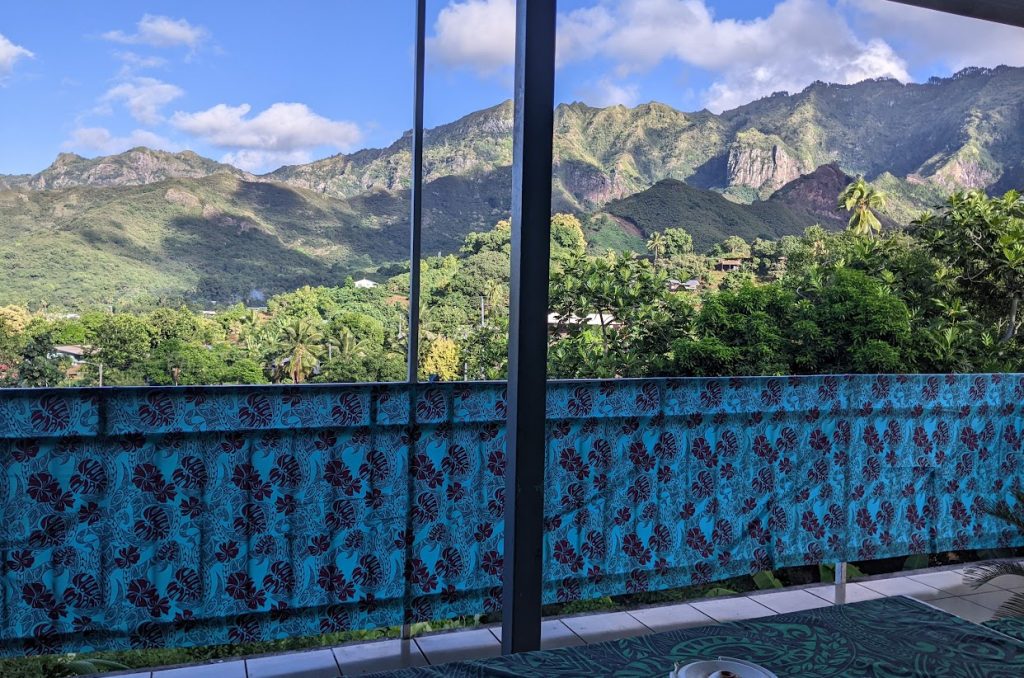
Thus begins my attempt at explaining how I feel about French Polynesia, now that we’re halfway through the trip. There are parts that I love, and parts that I really dislike, and strangely, some parts that I both love and dislike. But before I do that, I have to share with you something I have just this very minute realized, while trying to compose this sentence – or perhaps just admitted – about myself: I’m either a snob, or a spoiled brat, or a bit of (maybe a lot of) both. And, since I’m baring my soul, a bit of a hypocrite. Because every single thing I can think of that I have not liked about French Polynesia has to do with my own comfort, or my own biases, or my own opinions about how people should think and behave. Ugh… that hurts, but I can’t deny it.
We’re staying with Loic and Chantal because they operate a pension (pen-see-OWN), which means they rent out part of their house to tourists. Because we made all of our travel arrangements very last-minute, and because the only actual hotel on the island is about $400 per night, this is where we ended up. I applaud them for having the initiative to run a pension, because it usually means that your guests will not only be sleeping in your house, they’ll be eating with you, too – so you HAVE to have some breakfast ready every morning, and you HAVE to make dinner every night. (In addition to making dinner for yourself and your children – they have a 10 year old girl at home.) But to be honest, they haven’t exactly gone out of their way to spruce the place up for paying customers, and breakfast is the exact same three items each morning, and dinner is pretty monotonous as well, and not at all nicely presented. Chantal works full-time so she’s rarely here, and Loic speaks very little English, making any kind of conversation challenging at best. So I have this little dark cloud over my head, because the accommodations aren’t wonderful.
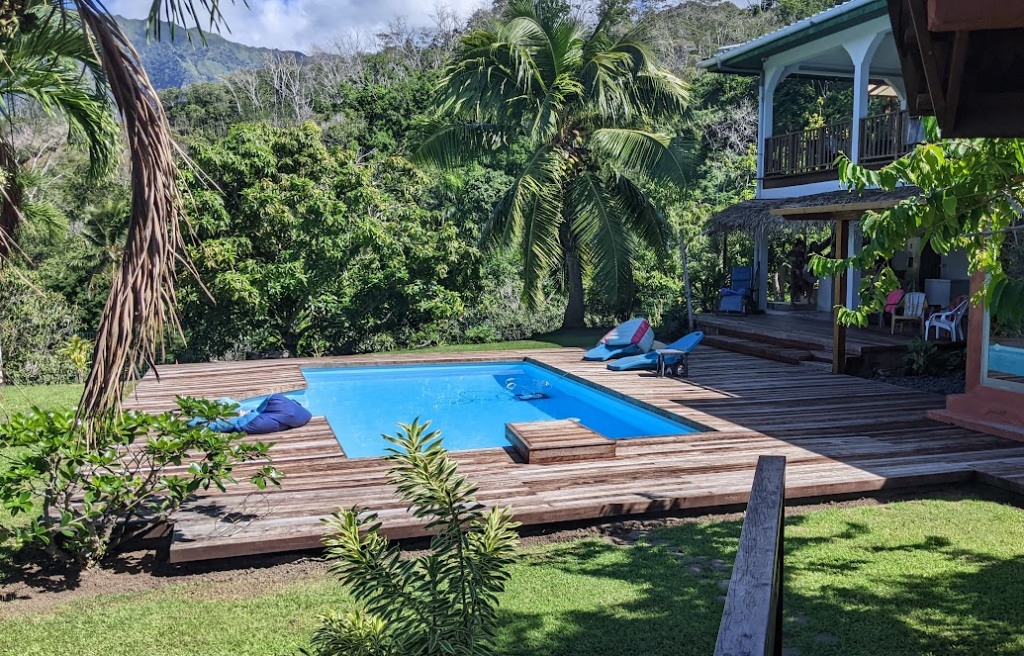
And it’s because the spoiled brat in me can’t help but compare this week’s stay with last week’s, when we stayed with Mimi# and Pierric# at their fabulous home on Hiva Oa, and enjoyed wonderful breakfast every morning, and interesting, delicious, and beautifully presented dinner every night, followed by lively conversation, and we slept in a perfect little bungalow beside their house, with the most incredible views all around. But the village of Atuona also rolled up the sidewalks before sundown, and we also were a long walk up an unlit road, so we also spent every evening in our room, without much to do except read or write.
(#These ARE their real names! And their place is called Villa Enata, on Hiva Oa, and you should stay there sometime!)
Similarly, I also didn’t love our first week on Rangiroa because of where we were staying, but my mood improved immensely when we relocated to a wonderful little bungalow with a much better location. Same atoll, same village, same amazing scuba diving, and we even got to spend time with good friends who also happened to be there the first week we were – and yet, I was unquestionably happier the four days we stayed at Rangiroa Cottage than I was the previous week.
Here’s another thing – Loic, our current host, was born and raised here on Nuku Hiva. His native language is Marquesan – he didn’t even start to learn French until he started school, and he has taught himself all the English he knows by watching YouTube, and by trying as hard as he can to communicate with his English speaking guests who haven’t bothered to learn more than about four words of Marquesan or French. So how in the hell am I the one who’s unhappy about the lack of communication happening between us? He’s trying – HARD – to communicate. And I’m not. And yet I’m the one who’s always complaining that Americans don’t value other cultures, other languages. Hypocrite much, Mr. Smith?
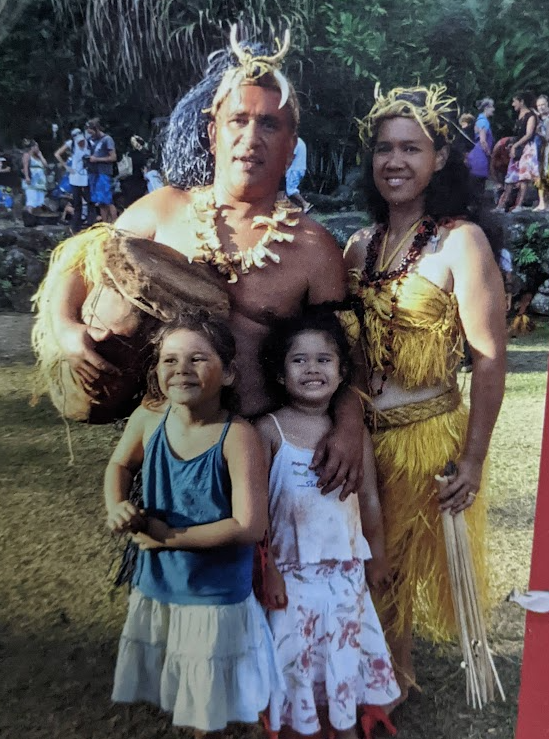
Alright, enough of the self flagellation. I now realize that if I tried to explain the things that I’ve not liked about French Polynesia, they would sound like the whinings of a spoiled brat, and should fall on deaf ears. Instead, let me dive into the things that I love about Nuku Hiva and French Polynesia, as there are many!
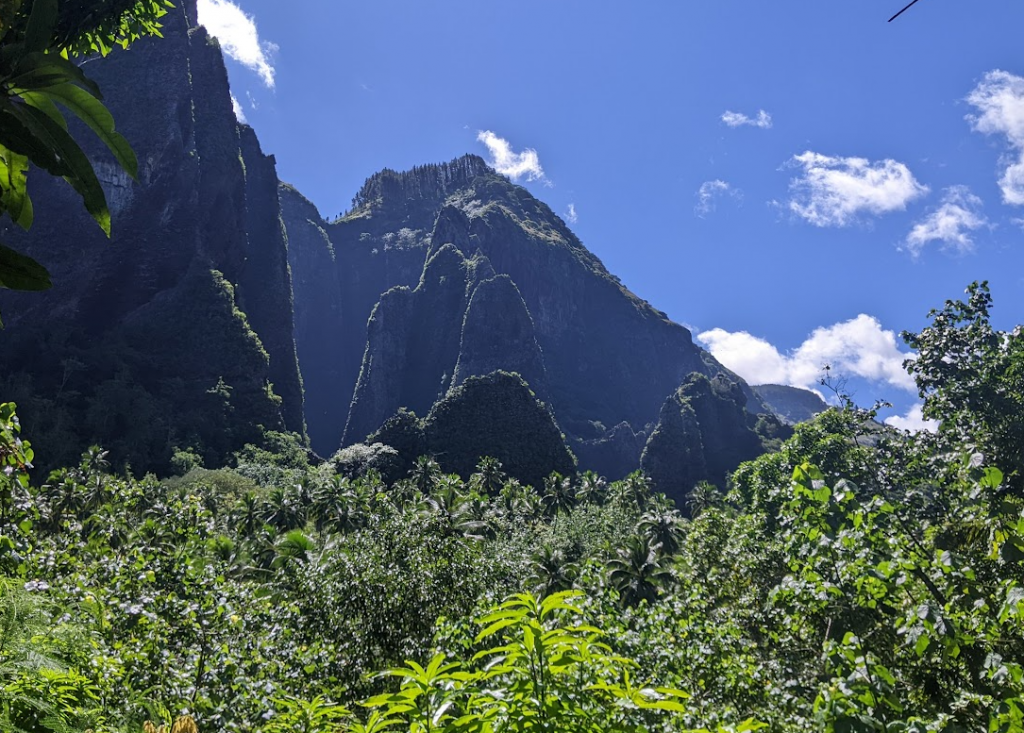
Like Hiva Oa, the landscape here is stunningly beautiful. Tall (over 3,000 feet) peaks jutting up from the sea, with sharp ridges and dramatic cliffs. Covered in green, which when you walk through it, is revealed to be a fascinating melange of flora. In our hikes the past two days, we have walked past coconut, breadfruit, starfruit, grapefruit, passionfruit, guava, banana, mango, almond, and papaya, all within picking distance. We have seen rosewood, bamboo, teak, wild hibiscus (a tree, not a bush), and manioc (better known to us as tapioca). Multiple colors and styles of hibiscus, bougainvillea, wild orchids, and a little purple flower you can eat, and it tastes like mushrooms!
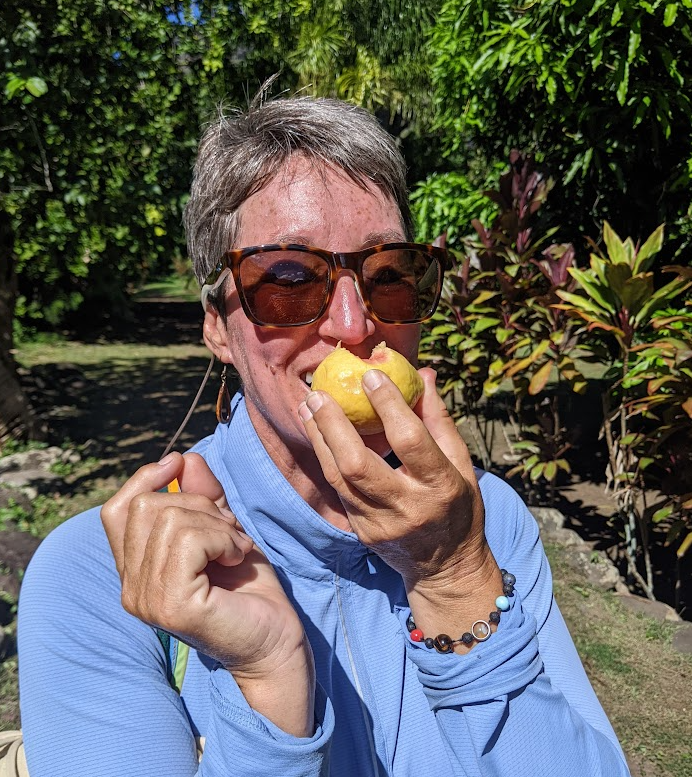
Our hike yesterday began with a 30 minute boat ride to another bay and beach, and on that ride we stopped for five minutes to watch eight or ten manta rays swimming all around the boat. (Oh, how we wanted to jump in with them!) The view of the cliffs and the peaks from the sea is spectacular, with the big swell crashing into the jagged rocks and sending water and spray 30 feet into the air. The views from the anchorages, where the sailboaters spend their time, are almost good enough to make me consider getting on a sailboat here for a tour of the islands. (Almost.) While we were hiking, the owner of the excursion boat and a couple of guests caught at least 20 fish of at least five different types, all of which would be frozen and sold in Tahiti for spending money. (Whatever they didn’t keep to eat, of course.)
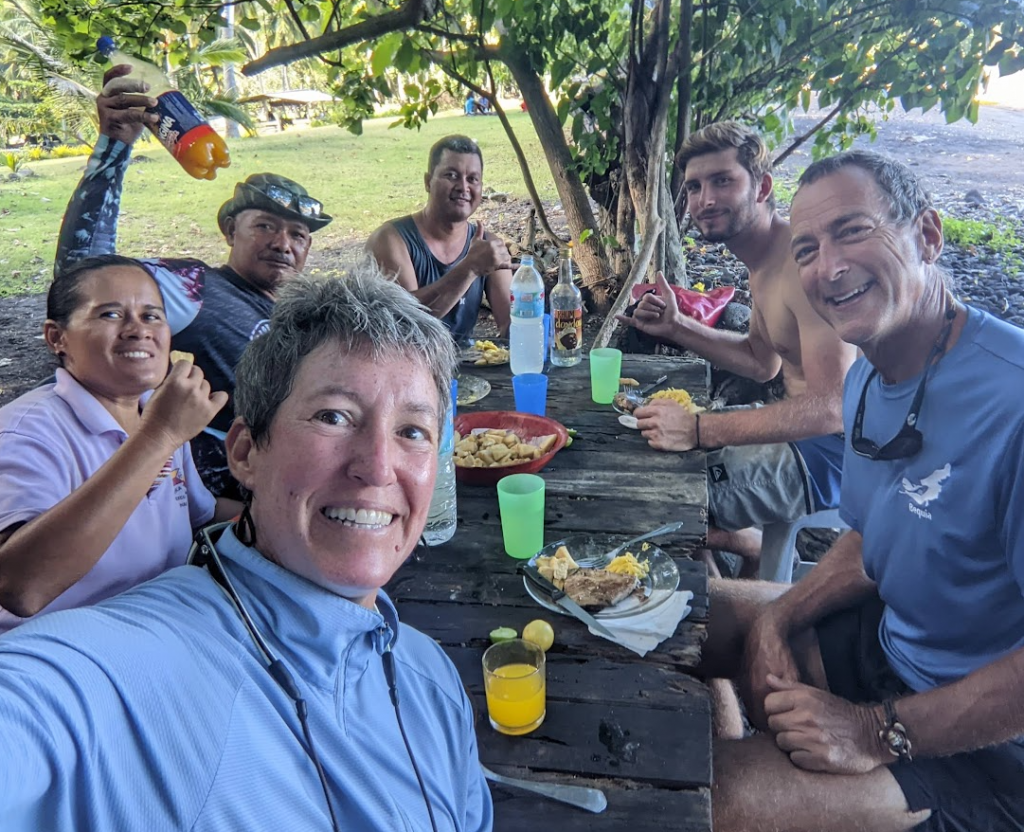
On our hike, which happened to be to a 1,000 foot tall waterfall, we met two different men coming the opposite direction. The first was easily in his sixties (probably seventies), and he was returning from a night hunting wild pigs with his dogs. His weapon? A big knife affixed to the end of an eight foot long wooden pole. The other gentleman was younger – maybe 30 – and he was wearing a necklace of wild pig tusks and bone that had come from animals he had personally hunted – probably with a weapon similar to the first gentleman’s. How much closer to the land can you live than that? How much more can you know about your source of protein than that?
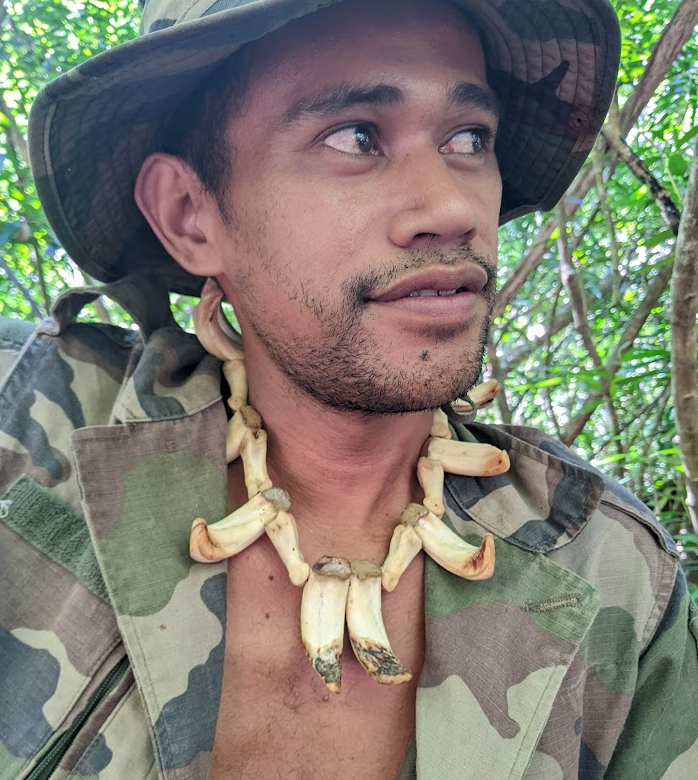
Everywhere you look you see evidence of the culture of these islands – stone tikis, carved poles supporting every roof and awning, tattoos that are almost exclusively of the old designs, designs so old that no one is even 100% sure what they mean (although there is general agreement on that). Boats bringing their fish and crustaceans to the public pier every morning after a night of fishing – with rod and reel, deep-drop rigs, handlines, and by freediving for the lobsters and crabs. You want fresh seafood? It’s at the pier, but not in the grocery store. Fresh produce? At the outdoor market next to the pier, not the grocery store. Drive anywhere and you’ll see the low covered platforms where the coconut is getting ready to be bagged and shipped to Tahiti: copra, the last step before the production of coconut oil.
One thing that I love, but am also a little disappointed in, involves all of the pre-European community sites. I love that evidence of the ancient history of the island is everywhere (you see houses built on top of the stone platforms – called pae pae – that were built hundreds of years ago), and I’m sad that it’s not being preserved, nor even very well researched (you see houses build on top of ancient stone platforms!). A busload of tourists can traipse all over a magnificant site like Tohua Koueva, and if they happen to dislodge a stone with their Birkenstock, that was placed there a thousand years ago, oh well! Some of these sites, with the clear evidence everywhere of them moving giant stones all over the place, are a bit mind-boggling, and it’s a shame they’re not valued more than they are.
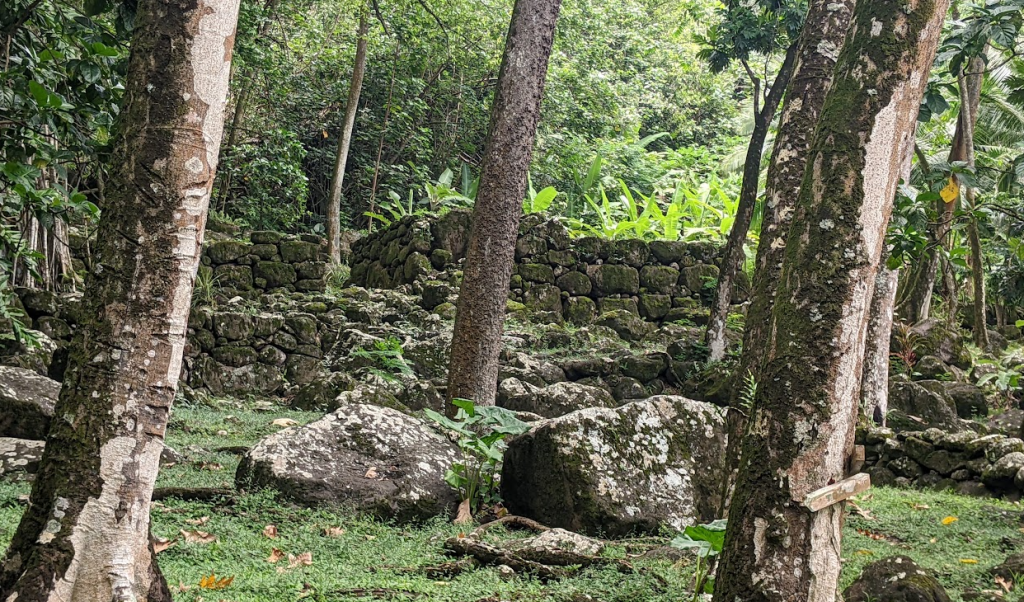
On five islands so far, we have not seen a single bar – a place where alcohol is the main attraction. Some restaurants sell beer, but most don’t. Some grocery stores sell alcohol, some don’t. Most don’t sell cold beer. Most of the people we’ve spent time with here don’t drink, or if they do, they drink only a little, or only occasionally. Everyone knows I love a good bar and a regular drink, but I can also appreciate a culture in which those things are not important.
I don’t have detailed knowledge of the education system here, but I do know that most kids who live on any island other than Tahiti go to Tahiti for high school. From about age 16, kids leave their homes and their families and travel long distances (particularly for Marquesan kids) to live for three or four years in a very unfamiliar place, simply for the sake of education. Even earlier than that, some kids go to “college” – a form of boarding school for kids in what we would call middle school or junior high school. Many young people, after high school, go to university in Tahiti or France. (It’s paid for by the government – what a concept!) Education is clearly important here!
Herman Melville, of Moby Dick fame, was here on Nuku Hiva for three or four weeks, when he and another guy deserted a whaling ship that had stopped here. He wrote his first novel about it – Typee. We have now visited the Taipivai valley each of the last three days, and it’s obvious why he chose to write a novel about this gorgeous place and its wonderful people. (By the way, at least 8,000 people are estimated to have lived in this valley before the decimation caused by visiting Europeans.)
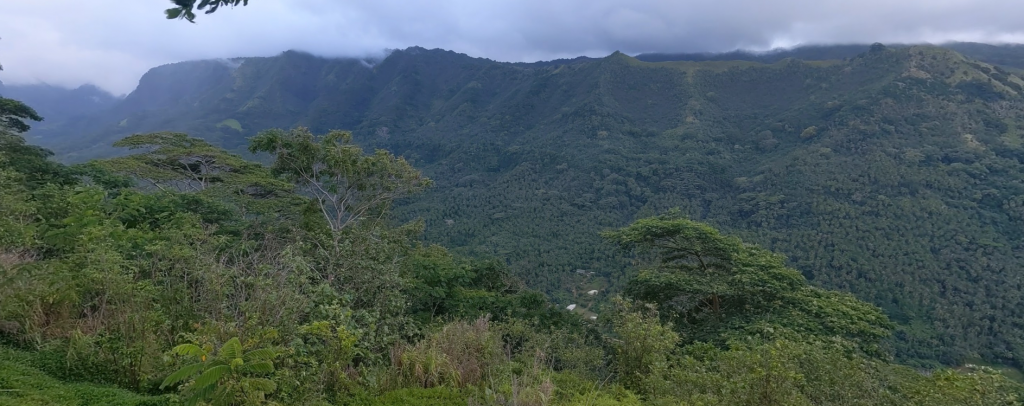
This is a place where the views are spectacular and the people are as real as people can be. No pretense, and tons of pride in their culture, which is rich and fascinating. You know, I think I like French Polynesia a lot! I’m just going to have to put a sock in it the next time I start to utter a complaint about where we’re sleeping that night.
P.S. – I originally wrote this two night ago. I’m pleased to report that, since my little epiphany spawned by that writing, I have had a wonderful time, all the time! Breakfast, dinner, and the funky smell in our bathroom have not improved, but my perspective has, and it’s made all the difference in the world!
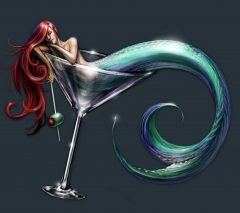
Most enjoyable.
What WAS the repetitive dinner?
Tuna carpaccio smothered in pesto, tuna sashimi served with their special sauce (Dijon mustard and ketchup), stewed goat in coconut milk, stewed pig (they call it “wild boar” but it’s just escaped domestic pig) with carrots and potatoes. Always served with white rice, and carrots: carrots and cucumbers sprinkled with lime juice, carrots and cucumbers and hard boiled egg, or carrots slightly sauteed (maybe?) with leftover grilled tuna. It sounds kinda exotic, and maybe it could be… but it’s not. Still… it’s what this family apparently eats, and it’s what we’re eating, and I’m not complaining – just reporting!
Boring sounds kind of nice right now, but no Trivia Taco Tuesday at the Tiki?
Hang in there, and thanks for letting us live vicariously through your posts.
Dani – no tacos and no trivia. Maybe in Tahiti?